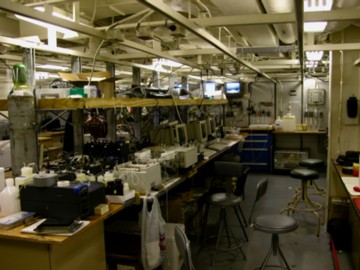|
|
Expedition
Expedition | People
|
Log - July-25-2003
by Gerhard Behrens and Robert McCarthy
Previous | Next
| Getting ready to collect important data |
| Last week, I said that part of being a scientist means having patience and perseverance because we all traveled a long way just to get to the starting place in St. John's, Newfoundland, Canada. Earlier this week I said flexibility was important because fog and engine problems slowed us down. As we keep steaming north, it is clear that organization is another life skill a scientist must have. |
 |
During the last few days, the scientists, the lab technicians, the mechanical specialists, and the Coast Guard science crew have been getting equipment ready and practicing on the equipment. Big bottles for collecting water samples have to be mounted on a "rosette," which is a steel cage that holds 24 bottles. The coring technicians must set up the long steel pipes that will take mud samples from the oceanÕs bottom. Lab technicians are setting up their chemistry labs so that water samples can be tested for things like oxygen, freon, barium, cadmium, phosphates, nitrates, and silicon. Scuba divers are getting ready to dive for clams and to help put pressure monitors on the sea floor. Everyone has to be ready to record their information, either on computers or on charts. It feels a little like the days before a big vacation, when everyone gets ready for the trip. Only, when we reach the waters of Baffin Bay we wonÕt be on vacation, there will be lots of work to do. |
| There are a few scientists who are already hard at work because the ship has a tool to measure the saltiness and temperature of the top seawater. There is another tool to make a map of the ocean floor. Someone has to watch these machines 24 hours a day to make sure they are working correctly. That takes cooperation, and just sitting there takes a lot of effort and perseverance.
|
| Much of the science work on the ship is difficult and dangerous. It is dangerous because the equipment going into the water is very, very, heavy. A crane or a winch will do most of the moving. There are lots of ropes, cables, and chains all over the place. Plus, all this work is happening on the deck of ship, 30 feet above the cold, dark waters of the ocean. It is difficult work because the equipment must be prepared in exactly the right way. Working for a long time and working at all times of the day or night makes it difficult, too. Since it is dangerous and difficult, my job is to watch and let the trained people work on the equipment. Maybe IÕll help later on.
|
| As we finish getting ready, much of our interest is in the mess (kitchen and dining room), where we eat like kings and queens. Click on the FUN FACTS button to find out more about the mess. |
|
